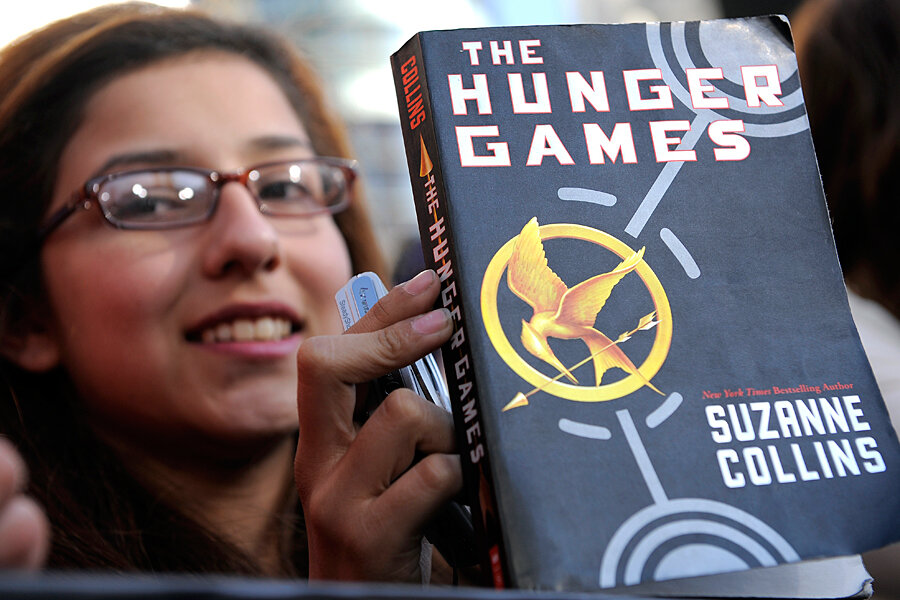What are kids reading? Books like 'Hunger Games,' but classics, too.
Loading...
What do green eggs, stick figures navigating the hazards of middle school, and post-apocalyptic teen battles have in common? They’re all to be found in the books most read by American children and teens.
The reading habits of 9.8 million students in Grades 1 to 12 are detailed in the new “What Kids Are Reading” report by Renaissance Learning in Wisconsin Rapids, Wis., which tracks students in 31,000 schools across the United States.
The annual report started five years ago “to encourage parents, teachers, librarians to find books that kids will enjoy ... and to encourage as much reading practice as possible,” says Eric Stickney, Renaissance’s director of educational research. “The amount of reading kids do is very predictive of how well they do on tests and how much they grow [academically].” [Editor's note: The original version of this story attributed the quotes in this paragraph, as well as one later in the story, to the wrong individual.]
Reading is tracked through Renaissance’s Accelerated Reader program, which enables students to take simple quizzes that show whether they actually read and understood a book. Quizzes are available for about 160,000 books, including most books for children and teens that can be found in schools and public libraries. It tracks not only assigned reading, but also many books that students pick up on their own time.
Out of 318 million books read in 2012-13, a select few rose to the top of the pop charts:
• “Green Eggs and Ham” by Dr. Seuss is No. 1 for first-graders, and it stays on the Top 20 list for second- and third-graders.
• Books in the “Biscuit” series by Alyssa Satin Capucilli are wildly popular in the early grades.
• Seven of the top nine slots in Grades 3, 4, 5, and 6 go to the “Diary of a Wimpy Kid” series by Jeff Kinney.
• For Grades 7 to 10, “The Hunger Games” by Suzanne Collins takes the top slot, with follow-ups “Catching Fire” and “Mockingjay” also in the Top 10.
• Among high-schoolers, some classics still manage to cling to Top 10 spots, such as “To Kill a Mockingbird” by Harper Lee, “Of Mice and Men” by John Steinbeck, “The Crucible” by Arthur Miller (No. 1 for Grade 11), “The Great Gatsby” by F. Scott Fitzgerald, and several works by Shakespeare.
“Anytime a book is turned into a movie ... the book shoots way up in popularity,” Mr. Stickney says, and “virtually all of the most popular titles are part of a series.”
Ever wonder how much students are reading these days?
The number of books that students read peaks in second grade, at an average of 55.
But the number of words students read in books peaks in sixth grade, when they average 16.2 books containing a total of 419,121 words.
In 12th grade, students are averaging 5.2 books a year, containing 304,252 words.
The gender gap in the average number of words students read peaks in eighth grade – with boys reading 340,515 words and girls reading 446,771.
The Common Core State Standards, adopted by the majority of states in recent years, are encouraging more reading of informational texts. But the balance of books kids read is still heavily in favor of fiction. Fifteen percent of books read by 12th-graders are nonfiction.
The Renaissance report includes lists of the most popular nonfiction books for each grade. For earlier grades, books about animals and various historical figures, ranging from Abraham Lincoln to Ruby Bridges, are the most popular.
The report shows slight gains since 2010 in the percentages of students reading books mentioned on the “exemplar lists” – the Common Core’s examples showing the increasing level of complexity to which students should be exposed in their reading.
One book appears in first or second place for Grades 6 all the way to 12: “A Child Called ‘It’: One Child’s Courage to Survive.” It’s Dave Pelzer’s memoir of growing up amid severe abuse by his alcoholic mother, who considered him “a slave ... and no longer a boy, but an ‘it,’ ” the back of the book jacket reads. “But his dreams kept him alive – dreams of someone taking care of him, loving him and calling him their son.”






